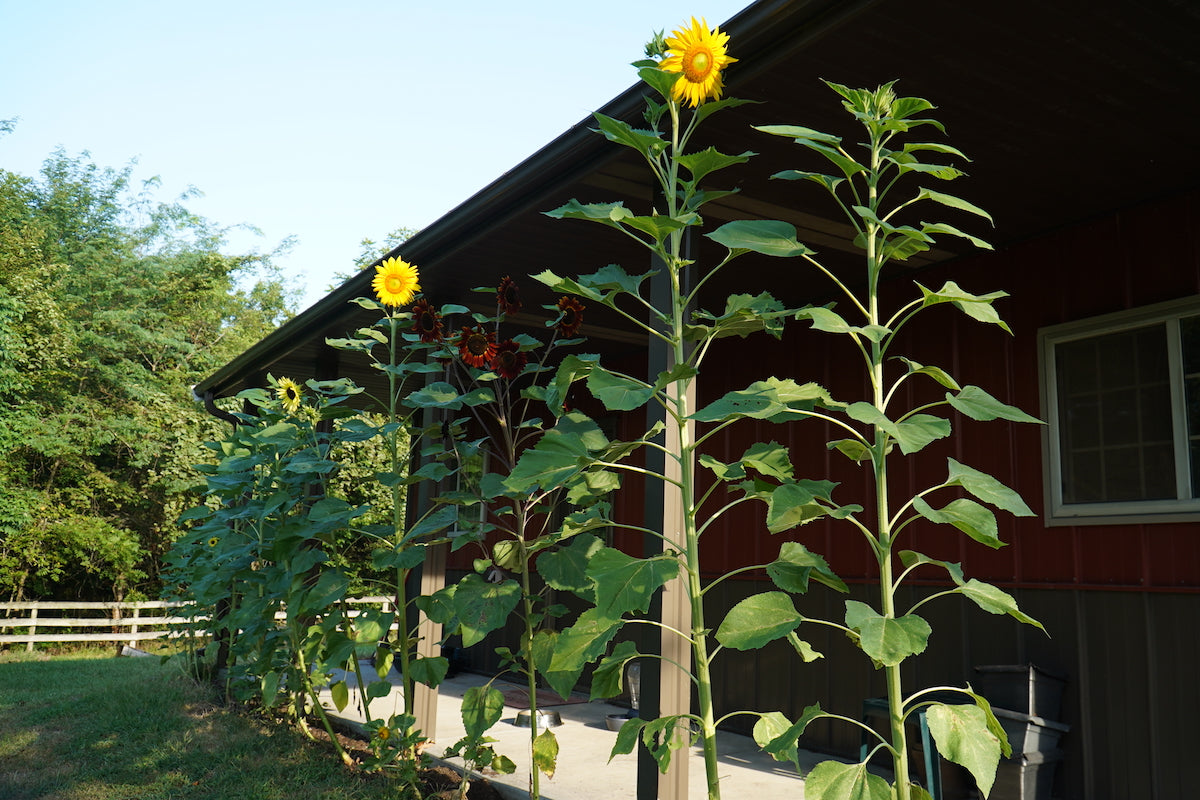To care for mammoth sunflowers, provide plenty of sunlight, water regularly, and support the tall stalks with stakes or trellises. With these simple steps, your mammoth sunflowers will thrive and produce beautiful blooms.
Growing sunflowers in your garden can bring joy and beauty to any outdoor space. Mammoth sunflowers, with their towering heights and large, vibrant blooms, are particularly impressive. Proper care is crucial to ensure these sunflowers reach their full potential. We will discuss the essential steps to care for mammoth sunflowers.
By providing adequate sunlight, regular watering, and providing support for the tall stalks, you can enjoy a stunning display of mammoth sunflowers in your garden. So let’s dive in and learn how to care for these magnificent plants.

Credit: www.reddit.com
How to Care for Mammoth Sunflowers: Step by Step Guide
Choosing The Right Soil And Location
Choosing the right soil and location is essential for the proper care of mammoth sunflowers. Understanding the sunflower’s soil preferences is the first step in selecting the ideal soil type. Testing the soil’s pH level helps determine if it is suitable for sunflowers. If necessary, organic matter can be added to improve soil texture. When choosing a location, consider the sunlight requirements of sunflowers.
They thrive in full sun conditions but can tolerate partial shade. Assessing wind conditions is also important, as strong winds can damage sunflower stems. Additionally, evaluate the available space to ensure there is enough room for the sunflowers to grow and spread their giant heads. By carefully selecting the soil and location for mammoth sunflowers, you can provide the optimal conditions for their growth.
Planting The Mammoth Sunflower Seeds
To care for Mammoth Sunflowers, it is important to properly plant the seeds. Start by selecting high-quality seeds. This ensures that you have the best chance of successful germination and growth. Conditioning the seeds before planting is another important step. This can be done by placing them in a damp paper towel for a few days to encourage sprouting.
Soaking the seeds before planting can help speed up the germination process. Simply place them in water overnight to soften the shell and promote quicker growth. Determining the right planting time is crucial, taking into consideration seasonal factors such as soil temperature and the risk of frost.
When planting the seeds, pay attention to the hole depth and spacing. Mammoth sunflowers need to be planted at least 1 inch deep and spaced adequately to allow enough room for growth. After planting, cover the seeds gently with soil and water them thoroughly. To retain moisture and support healthy growth, consider mulching the area around the seeds.
Providing Optimal Watering And Fertilization
Mammoth sunflowers are a stunning addition to any garden, but they require proper care to thrive. Providing optimal watering and fertilization is essential for their growth and development.
Establishing a watering routine is the first step to ensure your mammoth sunflowers receive adequate moisture. Determining frequency and amount of watering is crucial to prevent overwatering or underwatering. Regularly assessing soil moisture levels by checking the top few inches of soil can help you determine when to water.
When it comes to fertilizers, it is important to use appropriate ones for mammoth sunflowers. You can choose between organic or chemical options based on your preferences. Understanding the nutrient requirements of sunflowers will guide you in selecting the right fertilizer.
Lastly, applying fertilizers at the right time is crucial. It is recommended to fertilize when the sunflowers have reached a certain height or stage of growth. Following these guidelines will help you provide optimal care for your mammoth sunflowers!
Protecting From Pests And Diseases
Mammoth sunflowers are a beautiful addition to any garden, but like any plant, they can succumb to pests and diseases. It’s important to be able to identify the common pests that can attack sunflowers, such as aphids, caterpillars, beetles, sunflower midge, and weevils. To protect your sunflowers, implementing pest control measures is crucial. Consider using organic pest control methods first, and only resort to insecticides as a last resort.
In addition to pests, sunflowers can also become afflicted with diseases such as downy mildew, powdery mildew, rust, and stem rot. To prevent these diseases, it’s important to provide proper air circulation around the plants and regularly remove any infected foliage. If necessary, apply fungicides to the affected areas.
Caring for your mammoth sunflowers is a rewarding experience, and by being proactive in protecting them from pests and diseases, you’ll ensure they thrive and provide a stunning display in your garden.
Supporting Tall Sunflower Stalks
Supporting tall sunflower stalks is essential to ensure that they grow upright and stay healthy throughout their lifespan. Staking and tying the stalks are effective methods for providing the necessary support.
When it comes to staking and tying the stalks, it is important to choose the right support materials. Wooden stakes or bamboo canes are commonly used options. These materials are sturdy enough to withstand the weight of the sunflower stalks.
To install the stakes, dig holes in the ground near the base of the sunflower stalks. Insert the stakes deep into the soil, ensuring that they are firmly positioned. Place the stakes at least 2 feet away from the stalks to avoid damaging the roots.
Once the stakes are in place, tie the stalks securely using soft plant ties or garden twine. Start tying the stalks about halfway up and continue at intervals along the height of the plant. Avoid tying the stalks too tightly, as this can cause damage.
Monitoring the stability of the stalks is crucial. Regularly check for any signs of leaning or bending. After heavy rain or wind, it is especially important to inspect the stalks for any potential damage or instability. Adjust ties as needed to ensure the sunflower stalks remain upright and supported.
Encouraging Healthy Growth
Identifying when to prune: Regular pruning is essential for encouraging healthy growth in mammoth sunflowers. Look for signs of dead or weak branches, as well as spent blooms that need to be removed.
Removing dead or weak branches: By eliminating dead or weak branches, you allow the plant to focus its energy on the healthier parts, promoting better overall growth.
Encouraging side shoots: Pruning can stimulate the development of side shoots, which leads to increased branching and a fuller appearance for your sunflowers.
Deadheading for prolonged blooming: Deadheading involves removing spent blooms from the plant. By doing this, you encourage the sunflower to produce new blooms, extending the blooming period.
Identifying spent blooms: Regularly check for faded or withered blooms to identify which ones need to be removed. This helps redirect the plant’s resources towards new growth.
Proper deadheading techniques: When deadheading, make sure to cut the stem just above a leaf node or lateral branch to promote new growth. Use clean and sharp pruning shears for a precise cut.
Harvesting And Saving Seeds
To successfully harvest and save Mammoth Sunflower seeds, it is essential to recognize seed maturity. One way to monitor the back of the flower head is to observe the seeds’ color, which should turn from white to a greenish-yellow or black. Additionally, checking for dried petals and darkening seeds is a good indicator of maturity. Once the seeds are ready, it’s time to harvest them.
Cut the flower head at the right time, when the back of the head is turning brown and the seeds are plump. To collect the seeds properly, gently rub the flower head to release them into a container. After collection, air dry the seeds by spreading them in a single layer on a clean surface away from direct sunlight and moisture. Finally, store the dried sunflower seeds in a cool and dry place to ensure their longevity.
Frequently Asked Questions Of How To Care For Mammoth Sunflowers
Can Mammoth Sunflowers Survive In Shade Or Partial Shade?
Mammoth sunflowers require full sun for at least 6 to 8 hours a day to grow and thrive. They do not do well in shade or partial shade conditions. To ensure healthy growth and optimal blooming, it is essential to plant them in a location where they receive direct sunlight throughout the day.
How Often Should I Water Mammoth Sunflowers?
Mammoth sunflowers need regular watering, especially during hot and dry weather. Water them deeply once or twice a week, ensuring the soil is evenly moistened. It is crucial to water at the base of the plant to avoid wetting the leaves, as this can lead to disease and mildew issues.
When Should I Harvest Mammoth Sunflowers?
Mammoth sunflowers are ready for harvest when the back of their heads turns from green to yellow, the petals have withered, and the seeds are plump and dark. To prevent birds and squirrels from devouring the seeds before you harvest, consider covering the heads with small mesh bags or pantyhose until they are ripe.
Conclusion
Caring for mammoth sunflowers requires proper planning, attention, and regular maintenance. By following the tips discussed such as providing adequate sunlight, water, and fertilizer, you can ensure the healthy growth of these magnificent plants. Remember to protect them from pests, support their tall stems, and monitor their progress throughout the growing season.
With dedication and a little bit of patience, you’ll enjoy the stunning beauty of mammoth sunflowers in your garden. Happy gardening!

